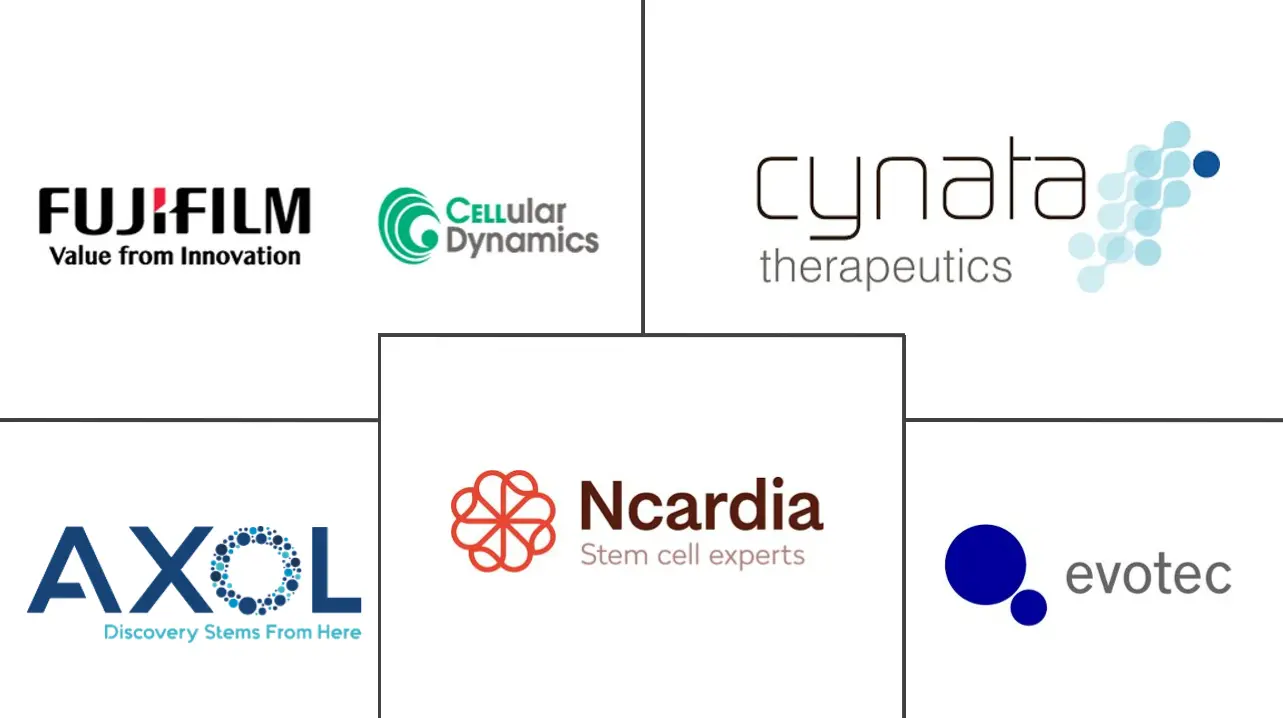Induced Pluripotent Stem Cells Market Size and Share
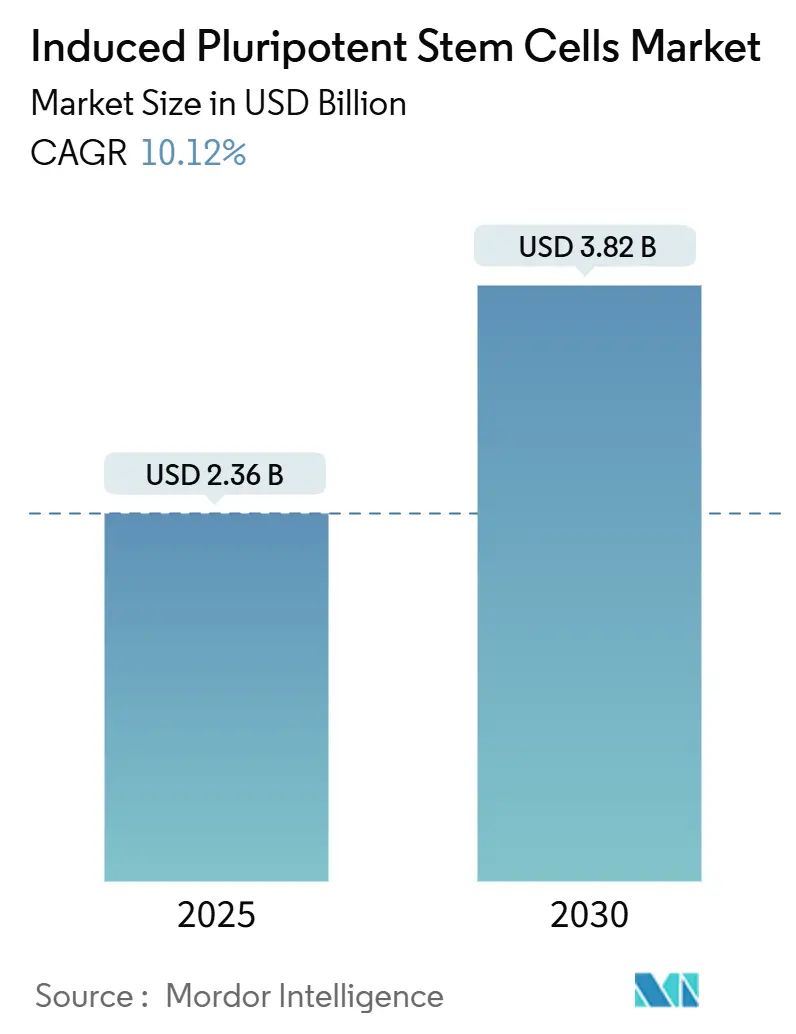
Induced Pluripotent Stem Cells Market Analysis by Mordor Intelligence
The induced pluripotent stem cells market size is estimated at USD 2.36 billion in 2025, and is expected to reach USD 3.82 billion by 2030, at a CAGR of 10.12% during the forecast period (2025-2030). Gains arise from clinical-grade manufacturing advances, growing therapeutic approvals and increasing regulatory support for cell-based products. North America continues to invest heavily through the National Institutes of Health (NIH) Regenerative Medicine Program, while Japan’s expedited review pathway is catalyzing Asia-Pacific growth.[1]Source: Smriti Mallapaty, “Japan’s Big Bet on Stem-Cell Therapies,” Nature, nature.com Pharmaceutical companies use iPSC models to cut late-stage trial failures, and breakthrough Parkinson’s and corneal regeneration trials have validated clinical relevance. Cost-efficient biomanufacturing platforms, artificial-intelligence-enabled quality controls and broader cross-sector consortia further accelerate market momentum.
Key Report Takeaways
- By derived cell type, cardiomyocytes led with 28.94% revenue share in 2024; neurons are forecast to expand at an 11.13% CAGR through 2030.
- By application, drug discovery held 40.23% of the Induced pluripotent stem cells market size in 2024, while regenerative medicine is advancing at a 12.43% CAGR to 2030.
- By end user, pharmaceutical and biotechnology companies accounted for a 58.79% share of the Induced pluripotent stem cells market size in 2024; academic and research institutes record the quickest growth at 12.85% CAGR.
- By geography, North America captured 37.51% of the Induced pluripotent stem cells (iPSCs) market share in 2024, whereas Asia-Pacific is projected to post a 12.32% CAGR to 2030.
Global Induced Pluripotent Stem Cells Market Trends and Insights
Drivers Impact Analysis
| Driver | (~) % Impact on CAGR Forecast | Geographic Relevance | Impact Timeline |
|---|---|---|---|
| Increase in global R&D funding for iPSC-based drug discovery | +2.1% | Global, with concentration in North America & EU | Medium term (2-4 years) |
| Growing prevalence of chronic & degenerative diseases spurring regenerative therapy demand | +1.8% | Global, with highest impact in aging populations of developed markets | Long term (≥ 4 years) |
| Continuous technological advances in iPSC reprogramming & differentiation platforms | +1.5% | Global, led by innovation hubs in US, Japan, and EU | Short term (≤ 2 years) |
| Increasing pharmaceutical adoption of iPSC models for high-throughput drug screening & toxicity testing | +1.3% | North America & EU primarily, expanding to APAC | Medium term (2-4 years) |
| Expansion of cross-sector (academia–industry) consortia accelerating clinical translation | +1.0% | Global, with strongest networks in US and Japan | Medium term (2-4 years) |
| Government funding programs and favorable policies supporting regenerative medicine initiatives | +1.2% | APAC core (Japan leading), spill-over to North America & EU | Long term (≥ 4 years) |
| Source: Mordor Intelligence | |||
Increase in global R&D funding for iPSC-based drug discovery
Pharmaceutical pipelines are pivoting toward human iPSC models because the U.S. Food and Drug Administration’s 2024 guidance formally accepted these platforms for toxicology submissions, giving developers regulatory clarity.[2]Source: U.S. Food and Drug Administration, “Potential Approaches to Drive Future Integration of New Alternative Methods,” fda.gov FUJIFILM Cellular Dynamics scaled daily output to billions of cells for drug screens, underscoring industrial demand. Collaborations between contract research organizations and cell-line specialists further widen access to off-the-shelf, QC-tested lines. Venture funding increasingly targets AI-driven image analysis suites that automate culture monitoring, shrinking manual workloads and cycle times. Together, these developments strengthen confidence in the Induced pluripotent stem cells (iPSCs) market as an alternative to animal testing and accelerate time-to-candidate selection.
Growing prevalence of chronic and degenerative diseases spurring regenerative therapy demand
The global aging trend raises incidences of neurodegenerative and metabolic disorders, reshaping healthcare priorities toward curative solutions. Japan’s clinical study that transplanted iPSC-derived pancreatic islet cells restored insulin production in type 1 diabetes patients, exemplifying therapeutic promise. Vision-restoration trials using corneal iPSC sheets achieved functional recovery with no rejection episodes, highlighting autologous benefits. Parkinson’s disease trials in the United States applied patient-specific iPSCs to replace dopaminergic neurons, demonstrating durable motor improvement.[3]Source: McLean Hospital, “Clinical Trial Tests Novel Stem-Cell Treatment for Parkinson’s Disease,” mcleanhospital.org These successes reinforce policy focus on regenerative medicine and sustain long-run expansion of the Induced pluripotent stem cells (iPSCs) market.
Continuous technological advances in iPSC reprogramming and differentiation platforms
Automated closed-system bioreactors now lower labor needs by 70% and cut per-batch costs by 50%. Chemical reprogramming protocols reduce genomic alteration risk while maintaining pluripotency. High-throughput microfluidic sorters remove undifferentiated cells at 3 million cells/minute, enhancing safety profiles. These innovations expand the Induced pluripotent stem cells (iPSCs) market beyond specialist labs and into mainstream biopharma operations.
Increasing pharmaceutical adoption of iPSC models for high-throughput drug screening and toxicity testing
Regulators encourage non-animal assays, prompting drug makers to integrate iPSC cardiomyocytes, neurons and hepatocytes into screening cascades. Purpose-built cell kits, such as atrial cardiomyocyte panels for arrhythmia evaluation, match specific preclinical endpoints and cut assay variability. The economic rationale is compelling: each late-stage failure avoided can save USD 100 million-plus in sunk costs, bolstering return on R&D and fueling repeat purchases within the Induced pluripotent stem cells (iPSCs) market.
Restraints Impact Analysis
| Restraint | (~) % Impact on CAGR Forecast | Geographic Relevance | Impact Timeline |
|---|---|---|---|
| Persistently high manufacturing costs and limited scalability of GMP-grade iPSC production | -1.9% | Global, with acute impact in cost-sensitive emerging markets | Short term (≤ 2 years) |
| Complex, evolving global regulatory frameworks for cell‐based therapeutics | -1.4% | Global, with regional variations in EU, US, and APAC | Medium term (2-4 years) |
| Safety concerns around genetic instability, tumorigenicity, and long-term efficacy | -1.1% | Global, with heightened scrutiny in developed regulatory markets | Long term (≥ 4 years) |
| Limited reimbursement pathways and insufficient cost-benefit evidence hindering widespread adoption | -0.8% | Developed markets primarily, with gradual expansion globally | Long term (≥ 4 years) |
| Source: Mordor Intelligence | |||
Persistently high manufacturing costs and limited scalability of GMP-grade production
Sub-50% utilization at several contract manufacturers signals process inefficiencies that inflate per-dose costs. LineaBio’s off-the-shelf GMP lines and OmniaBio’s AI-enabled facilities attempt to standardize yields, yet capital intensity remains a hurdle. Until unit costs fall, price-sensitive health systems may restrict reimbursements, tempering near-term adoption.
Complex, evolving global regulatory frameworks for cell-based therapeutics
Divergent regional standards necessitate parallel trial designs, driving overheads and delaying launch. The European Union’s SoHO regulation, effective 2027, raises documentation burdens but promises continent-wide reciprocity once complied with. In the United States, updated CBER guidance clarifies potency assays yet increases reporting frequency. Companies must allocate resources for continuous compliance, slowing expansion of the Induced pluripotent stem cells (iPSCs) market.
Segment Analysis
By Derived Cell Type: Cardiomyocytes Lead Therapeutic Applications
Cardiomyocytes captured 28.94% of total 2024 revenue, positioning them as the anchor for safety pharmacology and nascent heart-repair therapies. This dominance is tied to strict regulatory focus on drug-induced cardiotoxicity and to promising engineered-heart-muscle grafts that restored contractility in primate studies. The Induced pluripotent stem cells (iPSCs) market size for cardiomyocytes is projected to grow steadily in proportion to the expanding pipeline of biologics requiring rigorous cardiac screening. Neurons form the fastest-rising segment, advancing at an 11.13% CAGR as spinal-cord and Parkinson’s trials underline disease-modifying capacity. Hepatocytes remain indispensable for microsomal metabolism studies, while fibroblasts and keratinocytes support tissue-repair research in dermal and musculoskeletal fields.
Manufacturing advances underpin wider distribution of functionally mature cardiomyocytes, including automated maturation protocols that align electrophysiology with adult-like phenotypes. Neuronal lineage protocols benefit from refined patterning factors that yield subtype-specific populations suitable for high-content screening. Availability of curated cell banks via the European Bank for Induced Pluripotent Stem Cells assures reproducibility across laboratories. As chemistries to purge undifferentiated cells improve, lot-release hurdles ease, broadening commercial uptake across the Induced pluripotent stem cells (iPSCs) market.
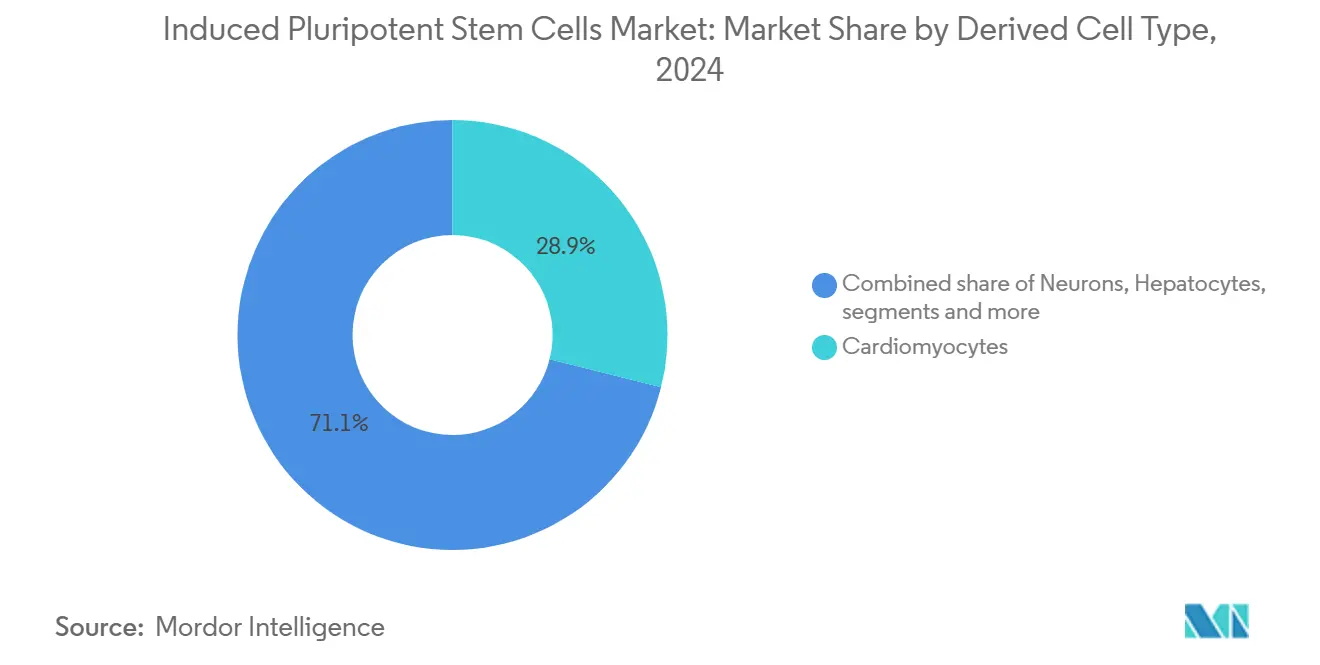
By Application: Drug Discovery Dominance Amid Regenerative Medicine Surge
Drug discovery accounted for 40.23% of 2024 sales. High-throughput studies that combine robotic plate handlers, optical mapping and calcium-flux analytics rely on standardized iPSC panels to expedite hit-to-lead workflows. The Induced pluripotent stem cells (iPSCs) market size tied to discovery is forecast to see incremental expansion as global R&D expenditure rises. Regenerative medicine, growing at 12.43% CAGR, is propelled by real-world patient successes, such as insulin-producing cell implants reversing glycemic instability. Disease-modeling contracts generate steady demand from rare-disease foundations seeking patient-specific insights, whereas toxicity testing gains ground through mandatory in vitro cardiac and hepatic safety panels.
Scale-up efficiencies and refined cryopreservation reagents help reduce cost per dose, particularly for allogeneic regenerative medicine platforms. Concurrently, AI-assisted image analytics shorten assay readouts, allowing more compounds per budget cycle. These synergies tighten integration of discovery and therapy business lines, reinforcing recurring revenue profiles for suppliers across the Induced pluripotent stem cells (iPSCs) market.
By End User: Pharmaceutical Sector Leadership with Academic Growth
Pharmaceutical and biotechnology firms maintained 58.79% revenue share in 2024 as regulatory obligations for human-relevant assays intensified. Their in-house and outsourced screens span cardiac, neuronal and hepatic panels, creating predictable bulk-volume orders. Academic and research institutions, however, show a 12.85% CAGR, reflecting broad grant funding and open-science commitments that encourage custom lineage generation and disease-model repositories. Contract research organizations bridge capability gaps for smaller biotechs, while hospitals and specialty clinics implement pilot autologous transplants for compassionate-use cases.
Public-sector initiatives such as the NIH Common Fund’s clinical-grade iPSC core lower entry barriers by providing validated lines and protocols. European reference centers deploy centralized quality-control frameworks to harmonize multi-site trials, boosting confidence among ethics boards. As universities license novel differentiation pathways, royalty streams emerge, broadening the Induced pluripotent stem cells (iPSCs) industry revenue model beyond traditional reagent sales.
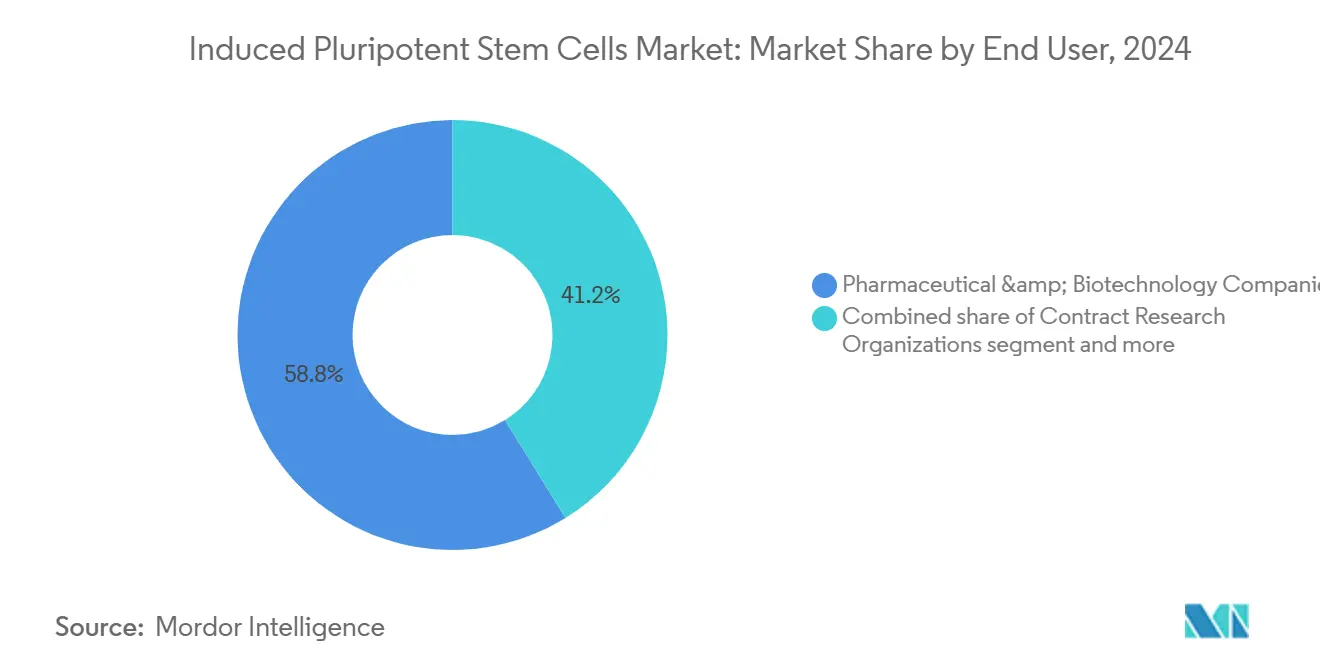
Note: Segment shares of all individual segments available upon report purchase
Geography Analysis
North America controlled 37.51% of 2024 revenue, supported by NIH allocations and an active venture-capital ecosystem. Regional hospitals hosted pivotal first-in-human Parkinson’s and cardiomyopathy trials, demonstrating translational leadership. The FDA’s progressive guidance on alternative methods accelerated uptake of in vitro panels, deepening domestic demand. Despite this, high labor and facility costs prompt firms to outsource certain manufacturing steps to lower-cost jurisdictions.
Asia-Pacific is projected to expand at a 12.32% CAGR to 2030, buoyed by Japan’s fast-track approvals and significant sovereign funding. China deploys provincial subsidies for GMP plant construction, while South Korea leverages electronics-grade automation expertise to scale closed-system bioreactors. The Induced pluripotent stem cells market has thus seen cross-border alliances where North American developers license clinical candidates to Japanese partners for rapid path-to-market access.
Europe remains a mature but cautious participant. The European Medicines Agency has issued detailed advanced-therapy guidelines that safeguard patient safety yet prolong dossier preparation. Harmonized test-method consortia, backed by the European Bank for Induced Pluripotent Stem Cells, maintain scientific leadership. However, constrained reimbursement landscapes hinder broad clinical adoption, compelling firms to prioritize proof-of-concept studies. Emerging regions—including the Middle East, Africa and South America—display pockets of interest, particularly in ophthalmology, but infrastructural gaps and nascent regulation limit immediate commercial scale within the Induced pluripotent stem cells (iPSCs) market.
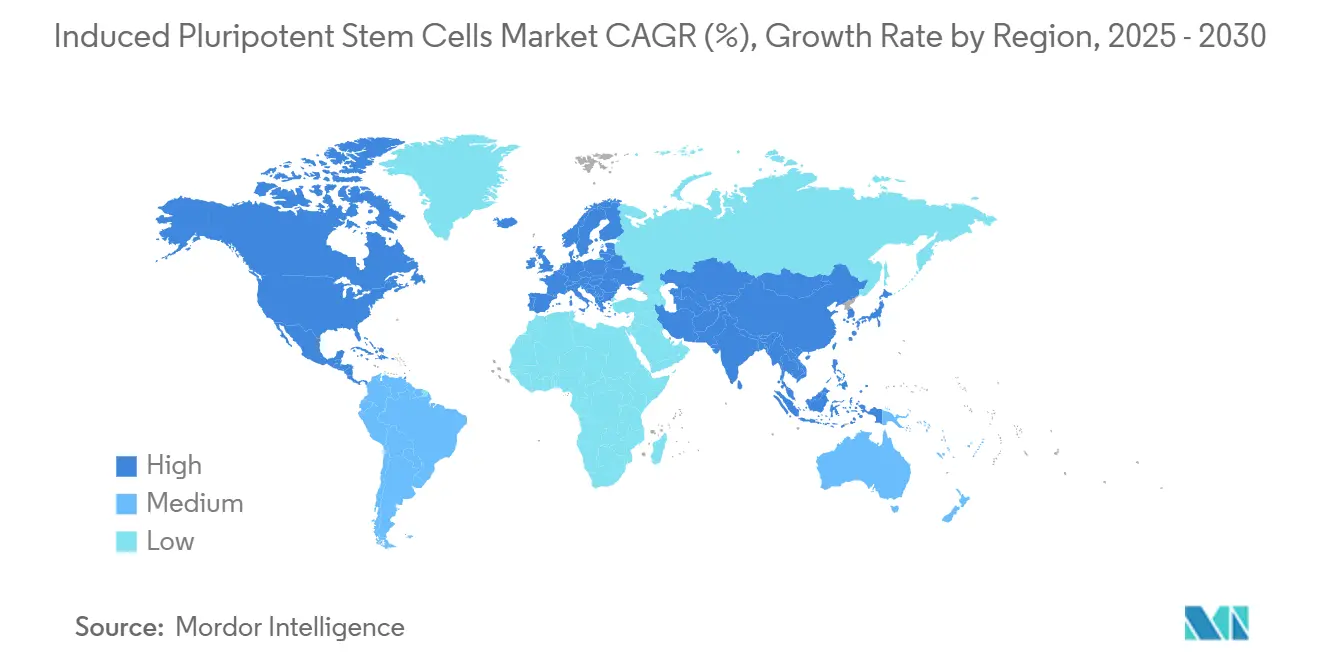
Competitive Landscape
The market exhibits moderate concentration. FUJIFILM Cellular Dynamics operates high-throughput lines capable of producing billions of iPSC-derived cells daily for pharmaceutical clients, providing an economies-of-scale moat. Fate Therapeutics commands a sizeable intellectual-property position with more than 500 patents covering engineered CAR-iNK and CAR-T assets. Century Therapeutics’ Allo-Evasion platform addresses immune rejection challenges, seeking first-mover advantage in off-the-shelf oncology indications.
Strategic collaborations shape the landscape. Lonza integrates cell-and-gene modalities into its service umbrella, offering end-to-end development support. Terumo partners with CiRA Foundation to automate large-scale reprogramming, targeting cost parity with biologics. Teknova and Pluristyx co-launched PluriFreeze to simplify cold-chain logistics, potentially unlocking broader global shipment of clinical-grade doses.
White-space opportunities persist in AI-driven in-line quality analytics, chemical reprogramming kits and rare-cell subtype libraries. Firms able to validate scalable, GMP-compliant chemical induction routes may disrupt current lentiviral and Sendai-virus methods, addressing residual safety concerns. Market entry barriers remain high due to capital intensity, rigorous regulatory oversight and the need for multi-disciplinary expertise, yet first-movers that can streamline cost and demonstrate compelling clinical efficacy are set to expand share in the Induced pluripotent stem cells (iPSCs) market.
Induced Pluripotent Stem Cells Industry Leaders
-
Axol Bioscience Ltd.
-
Evotec SE
-
FUJIFILM Cellular Dynamics, Inc.
-
Ncardia BV
-
Cynata Therapeutics Ltd.
- *Disclaimer: Major Players sorted in no particular order
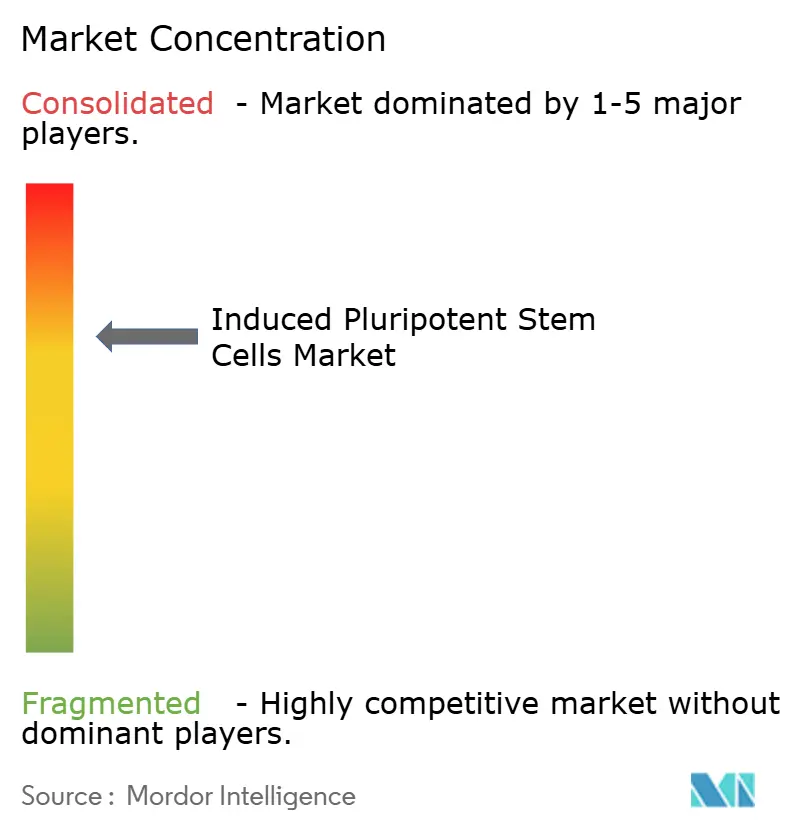
Recent Industry Developments
- March 2025: Pluristyx and Teknova launched the PluriFreeze cryopreservation system to improve iPSC storage and shipping efficiency.
- June 2024: FUJIFILM presented expanded iPSC technology offerings at the BIO International Convention, highlighting scale-up readiness.
- May 2024: Cambridge Bioscience partnered with Axol Bioscience to distribute specialized iPSC-derived cell products across the UK and Ireland.
Research Methodology Framework and Report Scope
Market Definitions and Key Coverage
Our study defines the induced pluripotent stem cells (iPSC) market as the value generated from products, services, and enabling technologies that reprogram adult somatic cells to a pluripotent state and subsequently differentiate them into lineage-specific cells for research, screening, and therapeutic use. According to Mordor Intelligence, figures include revenues from cell lines, culture media, reprogramming kits, downstream analytical tools, and fee-based manufacturing services purchased by laboratories, biopharma firms, and academic centers worldwide.
Scope exclusion: Embryonic, adult, and hematopoietic stem cell products that do not pass through an iPSC reprogramming step are excluded.
Segmentation Overview
- By Derived Cell Type
- Cardiomyocytes
- Neurons
- Hepatocytes
- Fibroblasts
- Keratinocytes
- Other Cell Types
- By Application
- Drug Discovery and Development
- Disease Modeling
- Toxicity Testing
- Regenerative Medicine
- Cell Therapy
- Tissue Engineering
- Other Applications
- By End User
- Academic and Research Institutes
- Pharmaceutical and Biotechnology Companies
- Contract Research Organizations
- Hospitals and Specialty Clinics
- Other End Users
- By Geography
- North America
- United States
- Canada
- Mexico
- Europe
- Germany
- United Kingdom
- France
- Italy
- Spain
- Rest of Europe
- Asia Pacific
- China
- Japan
- India
- Australia
- South Korea
- Rest of Asia Pacific
- Middle East and Africa
- GCC
- South Africa
- Rest of Middle East and Africa
- South America
- Brazil
- Argentina
- Rest of South America
- North America
Detailed Research Methodology and Data Validation
Primary Research
Mordor analysts interview GMP cell-manufacturing directors, academic PIs, supply-chain managers, and regulatory advisors across North America, Europe, and Asia-Pacific. These conversations test price points for clinical-grade batches, typical success rates in reprogramming, and adoption intentions so that we refine desk findings and close data gaps before final triangulation.
Desk Research
We begin with a structured sweep of open datasets such as US NIH RePORTER grant logs, FDA RMAT designations, European Medicines Agency ATMP registers, OECD R&D spending tables, and clinical-trial postings that track iPSC pipelines. Statistical yearbooks from the World Health Organization, customs trade codes for pluripotent stem cell reagents, and publications in PubMed and Nature Biotechnology complement the view. Commercial signals are drawn from company 10-Ks, investor decks, and D&B Hoovers subscriber feeds (for revenue splits), while Dow Jones Factiva screens business news for investment rounds and acquisitions. This source list is illustrative, not exhaustive, as many additional references guide data checks.
Market-Sizing & Forecasting
A top-down construct links national biomedical R&D outlays and translational grant pools to estimated iPSC demand pools, followed by adjustment through sampled average selling price times volume data from supplier interviews. Bottom-up cross-checks include roll-ups of publicly reported reagent sales, contract manufacturing capacity utilization, and select hospital procurement audits. Key model drivers are: 1) average reprogramming efficiency, 2) clinical trial enrollments using iPSC-derived cells, 3) grant inflow to disease-modeling projects, 4) GMP facility start-ups, and 5) price erosion curves for high-volume cardiomyocyte and neuron lots. Forecasts employ multivariate regression linked to these drivers, complemented by ARIMA smoothing for short-term fluctuations. Assumption gaps in bottom-up samples are bridged with regional import data and validated expert ranges.
Data Validation & Update Cycle
Outputs pass variance scans against independent metrics, and anomalies trigger analyst re-checks. Senior reviewers sign off only after multi-step peer review. We refresh every twelve months, yet interim updates activate when material events, such as major approvals, supply shocks, or currency swings, shift fundamentals; a final validation pass is completed just before release.
Why Mordor's Induced Pluripotent Stem Cells Baseline Earns Early Trust
Published estimates differ because firms pick unique scopes, base years, and uptake curves. Some count only reagent sales, whereas others mix in organoid platforms or broader stem-cell therapy revenues.
Key gap drivers include varying inclusion of Asia-Pacific service contracts, divergent price-decline assumptions for cardiomyocyte lots, and refresh cadences that may lag fast pipeline progress. Mordor's disciplined annual refresh and dual-approach model mitigates these variances, yielding the dependable baseline clients need.
Benchmark comparison
| Market Size | Anonymized source | Primary gap driver |
|---|---|---|
| USD 2.36 B (2025) | Mordor Intelligence | - |
| USD 1.84 B (2024) | Global Consultancy A | Excludes Asia service revenues; relies mainly on company revenue roll-ups |
| USD 1.93 B (2024) | Industry Publication B | Treats organoid platforms as separate sub-market, trimming core iPSC value |
| USD 1.60 B (2025) | Regional Consultancy C | Conservative adoption rates and limited hospital R&D capture |
The comparison shows that differing scopes and aging assumptions drive most gaps, while our regularly updated, variable-anchored framework delivers a transparent, reproducible starting point for strategy and investment planning.
Key Questions Answered in the Report
What factors are encouraging pharmaceutical companies to replace animal models with iPSC-based assays?
IPSC platforms better mimic human biology, improve prediction of drug toxicity, and reduce late-stage clinical failures—delivering tangible savings in development time, resources, and regulatory risk.
How are regulatory agencies influencing adoption of iPSC technologies?
Agencies in the United States, Europe, and Japan have issued guidance that recognizes iPSC models as acceptable alternatives for safety testing and have created expedited review pathways for cell-based products, giving developers added confidence to invest.
Which iPSC-derived cell types are most sought after by drug developers and why?
Cardiomyocytes, neurons, and hepatocytes are in highest demand because they address critical safety endpoints—cardiotoxicity, neurotoxicity, and metabolism—that historically account for many drug candidate failures.
What manufacturing innovations are easing cost and scalability barriers in iPSC production?
Automated closed-system bioreactors, AI-assisted quality-control analytics, and standardized off-the-shelf GMP cell lines are reducing labor requirements, shortening production cycles, and improving batch consistency.
How are academic–industry partnerships accelerating clinical translation of iPSC therapies?
Consortia combine academic discovery with industrial GMP expertise, enabling faster protocol optimization, shared infrastructure, and streamlined regulatory documentation, thereby shortening the bench-to-bedside timeline.
What principal safety concerns do regulators monitor for iPSC-derived products?
Authorities focus on genetic instability, residual undifferentiated cells that could form tumors, and long-term functional durability, requiring rigorous characterization and release testing before clinical use.
Page last updated on:
